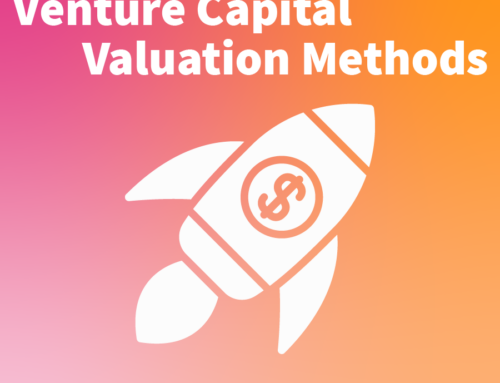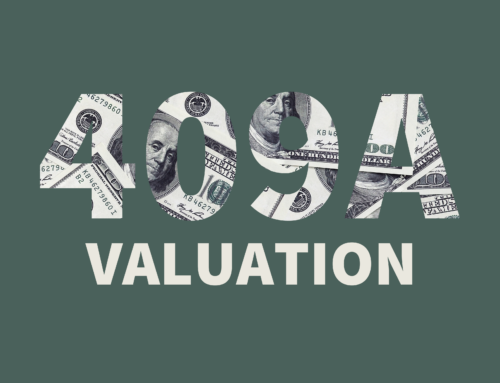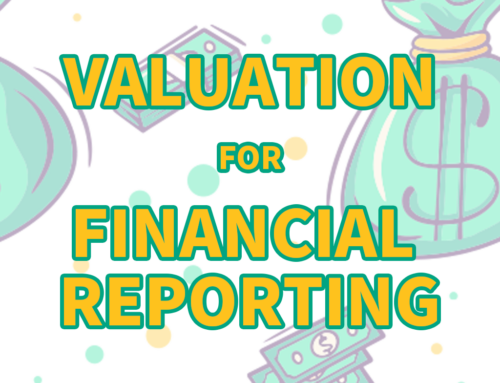VALUATION 101
What is a Valuation?
In theory, a valuation is simply the estimated worth of an asset, liability, or company. In practice, getting to a useful valuation is almost never that simple.
Why is a Valuation Needed?
One of the drivers of complexity in valuation is methodology selection. In most situations, there are at least two different approaches to choose from, like cost or market pricing. But even before selecting a valuation method, it’s critical to understand the reasons why organizations need valuations in the first place.
We’ll discuss these common reasons for valuation, along with the methodologies that often associate with those reasons, in the sections below.
Operational
The most common reason for valuation is regulation, typically related to IRS or SEC reporting requirements. These types of valuations are generally subject to more specific guidelines, often with a focus on “observable” or “objective” inputs rather than subjective ones.
Financial Reporting
For example, US GAAP lays out specific requirements and methods for valuing assets and liabilities. Public companies must follow these requirements when preparing their financial statements. Non-public companies who are required to follow GAAP will have to follow these same standards; this often comes up for Employee Stock Option Plans (ESOPs) or for purchase price allocation (PPA) associated with acquisitions.
Tax
The need to establish a valuation for tax purposes can vary broadly: from estate and gift tax filing to Section 83(b) elections or corporate structure conversions; in all cases, however, valuation is needed to comply with IRS regulations. State and local tax almost always follow Federal standards for calculations like these, so we’ll limit our discussion in this article to US Federal tax guidance.
Bankruptcy and Restructuring
While there are strategic elements at the beginning of planning for a distressed entity, once an approach has been decided (e.g., Chapter 7 vs. 11), the ensuing valuation is primarily driven by statutory requirements.
Strategic
Valuations that are performed for a strategic purpose are often less prescriptive; while these may include a number of subjective factors, they still serve a valuable purpose. Valuations can enable companies, founders, executives, and external stakeholders to make better decisions to improve the company’s standing.
Fundraising
You can’t talk about raising funds without talking about valuation! (Well, unless you’re delaying the valuation discussion with convertible debt or a SAFE.) We’ll discuss some of the more popular methods of valuation in the venture capital space later in this post.
M&A Activity
Valuations are essential to exit planning; knowing whether, when, and how to exit is a complex decision, but having a good understanding of what a company’s valuation is currently, could be in the future, and could be post-acquisition/spinout/merger/divestiture is key to having a clear understanding of a possible transaction.
Estate and Succession Planning, Divorce, and Personal Borrowing
It’s tough to make an informed decision about your estate if you don’t know what your business (or ownership of it) is worth. Valuations are an important tool in developing strategies for both estate taxes and succession planning. They’re also an essential part of negotiating contentious situations, such as a hostile divorce – with both parties in direct conflict, an independent third-party valuation is generally required. Founders or other owners may also find themselves requesting an external valuation of their company (or stock) so that they can borrow against the value (either directly or indirectly).
Factors that Influence Valuation
In addition to the actual inputs used to calculate a company’s valuation, there are numerous other concomitant factors that influence it.
Market Conditions
Though not all valuation methods explicitly take market conditions into account, these conditions can impact a company’s enterprise value. If the valuation method that’s utilized doesn’t account for these, it’s a best practice to take the valuation with a grain of salt and try to adjust expectations based on current and projected conditions.
Factors such as interest rates, regulations, consumer demand, and supply chain risk impact businesses both broadly and specifically. The difference between a 1% interest rate and a 3% interest rate can significantly impact a company’s valuation that is based on discounted cash flows. Changes in interest rates can also impact how investors position their capital and what type and degree of risk they’re willing to accept.
New or strengthened regulations create opportunities for some businesses (e.g., cookie consent management for GDPR compliance) while signaling the death knell for others (e.g., tobacco products).
Stage of Business
Early stage businesses generally have significantly greater uncertainty than later-stage businesses: product-market fit, adoption, leadership team performance, founder disputes, and – existentially – whether they can even continue as a going concern.
There is an inherent selection bias when assessing later stage companies; these companies are the ones that succeeded in moving beyond their early stages. Failed startups are not part of the picture at this point (unless it’s part of the assessment of the leadership team’s business experience).
By their very nature, early stage companies lack the track record that later stage companies do; consequently, valuations tend to be lower or ranges larger in the early stages to account for the associated risks. Early stage valuations look much different from later stage valuations (think Series A and beyond, although as we’ve discussed, these distinctions can be fairly nebulous). Without financials and customer metrics to rely on, early valuations are much more qualitative in nature. They may consider factors such as the founders’ startup experience, the makeup of the leadership team, and the company’s development thus far (e.g., ideation, minimum viable product).
Industry
The industry in which a company operates can significantly impact its valuation: both the method of valuation that’s used, as well as the individual factors within a given method.
Some industries, such as healthcare technology, pharmaceuticals, and biotechnology, have high initial capital requirements and long timeframes before any expected profits. Investors in these industries take into account the fact that profitability is often years away when they value a potential investment. Conversely, a pharmaceutical company that is in New Drug Application (NDA) Review may garner a much higher valuation, given that much of the risk has already been addressed. Valuation in these spaces may be more heavily influenced by a company’s intellectual property, particularly granted patents.
Other industries, such as SaaS, can scale rapidly and generally are valued based on their likelihood of doing so. Metrics about user adoption and annual or monthly recurring revenue (ARR or MRR) take center stage in valuation determinations.
Context for Valuation
The reason behind performing a valuation can drive the valuation itself. Valuation for the purpose of raising external funds can vary significantly from a valuation calculated to meet a 409A requirement – even at the same point in time. In some cases, the valuation techniques follow specific requirements (these are often driven by the IRS and FASB), while in other cases it’s more of a case of “beauty is in the eye of the beholder.”
If a valuation is being performed as part of an adversarial situation, such as a contentious divorce or feuding co-owners, one side may be seeking the lowest possible valuation, while the other seeks the highest.
Valuation Methods
Diving into the specifics of various valuation methods can be more than you bargained for. Given that, today’s post will simply highlight some of the frequently used methods of valuation, as well as identifying when it is appropriate to use each one. If you’re looking for a deeper dive on these methods, stick around, as we’ll be expanding on these in upcoming posts.
Reorganization Value (ASC 852)
Reorganization value focuses on how much an entity is worth after the completion of some type of restructuring event.Specifically, ASC 852 states that this value “approximates the amount a willing buyer would pay for the assets of the entity immediately after the restructuring.” Unlike fair value, reorganization value is based on assumptions that are negotiated or determined by the bankruptcy court.
Fair Value for Financial Reporting (ASC 820)
Fair value reporting is what is required under US GAAP. Fair value is defined in ASC 820-10-20 as “the price that would be received to sell an asset or paid to transfer a liability in an orderly transaction between market participants at the measurement date.” This method is used for SEC financial reporting, other GAAP financial reporting, and employee benefit plan reporting.
These standards allow for three different approaches to valuation, but frames them in a hierarchy, with lower-level approaches only allowed if the prior approaches cannot be used.
ASC 820 allows for a variety of valuation techniques, including a market approach, an income approach, and a cost approach. Depending on the nature of the asset or liability, one approach may be a more appropriate fit than another.
Our next post takes a deeper dive into valuations for financial reporting purposes.
Deferred Compensation (IRC §409A)
Often referred to as Section 409A valuations, independent valuations to determine the fair market valuation of a company’s common stock. These are typically used to calculate deferred compensation (usually non-qualified stock options or NQOs) and are required in order to prevent penalties to both the company and its employees. 409A valuations provide companies with a “safe harbor” under which the IRS will not rebut the FMV assessment unless it is “grossly unreasonable.”
Fair Value for Estate and Gift
Valuations for estate or gift tax purposes (versus estate planning) are required by the IRS when a non-sale transaction occurs (such as the death of a founder or shareholder, or gifting of business ownership interest) that meets certain requirements. Per 26 CFR § 20.2031-1(b), for estate tax purposes fair market value is “the price at which the property would change hands between a willing buyer and a willing seller, neither being under any compulsion to buy or to sell and both having reasonable knowledge of relevant facts.” It’s important to note that the fair market value, particularly for privately-held companies, is often discounted due to limited marketability/liquidity of the ownership and (if applicable) due to limited control or associated minority interests.
Cost to Rebuild/Replace
The focus here is not what it cost to originally build or buy your product; instead, it is what it would cost someone else today to rebuild or replace it. This type of valuation is often used in insurance or in build vs. buy assessments.
VC-Utilized Methods
Venture capital methods of valuation often rely on more subjective factors, as the companies in which they invest may not have a sufficient financial track record upon which to establish a valuation. Below are some of the more common methods used by VC to determine a company’s valuation:
Venture Capital Method – this is a valuation method that works backwards beginning with the company’s projected future exit value and uses the investor’s expected rate of return and anticipated dilution to arrive at a pre-money valuation of the company today.
Payne Scorecard – this method compares the target company to comparable companies across a number of factors; the target’s pre-money valuation is determined by adjusting the comparable valuations upwards or downwards based on the target’s anticipated strengths or weaknesses across a number of areas (e.g., total addressable market (TAM), competitive environment).
Berkus Method – this method is used for pre-revenue companies and assigns specific dollar amounts to a pre-money valuation based on risk factors associated with the stage of development and execution of their vision.
Know Your Goal
Whether you’re looking to value your own company or a potential investment or acquisition, it’s important to understand the why behind the valuation: is it required? Will it help you develop a strategic roadmap? Are you looking to hire employees and want to offer equity? The driving force behind the valuation shapes the valuation itself: who performs the valuation, what factors are considered, the frequency of the calculations, and more. Having a clear understanding of your goal puts the “value” in valuation (we were so close to making it through a post without a bad pun).
Our Dilligencer platform enables us to quickly assess comparables using market data and to assess internal factors; our analysis goes beyond market comps to assess the specifics of your business. We offer valuation services to fit a broad range of needs: whether you’re looking for a valuation as a starting point before beginning the next round of fundraising or considering spinning out a specific product, Licens.io has you covered.







